Investigations into the Air India plane crash are looking into the pilots’ medical records as it’s claimed one of them had depression and mental health issues.
Captain Sumeet Sabharwal, an experienced pilot with more than 8,200 hours in the cockpit, was piloting the Boeing 787 Dreamliner when it plummeted into a residential area, called Meghani Nagar, killing 241 people on board and claiming 19 more lives of those on the ground.
Seconds after taking off on June 12, two fuel switches in the cockpit of Air India Flight 171 were turned off shortly after take off, resulting in a catastrophic loss of power and the aircraft crashing to the ground.
The switches’ ‘locking feature’ meant pilots had to lift them up before changing their position, they are not simple push buttons which can be accidentally turned off.
Now, investigations into the tragic crash have begun to analyse the behaviour of the pilot.
Captain Mohan Ranganathan, a leading aviation safety expert in India, has revealed that ‘several’ Air India pilots had allegedly confirmed that the well-experienced pilot had suffered from poor mental health.
Speaking to The Daily Telegraph, he claimed: ‘He had taken time off from flying in the last three to four years. He had taken medical leave for that.
Captain Sabharwal is also understood to have taken bereavement leave after the death of his mother, though it is believed by Mr Ranganathan that he had been ‘medically cleared’ by Air India prior to the fatal crash last month.
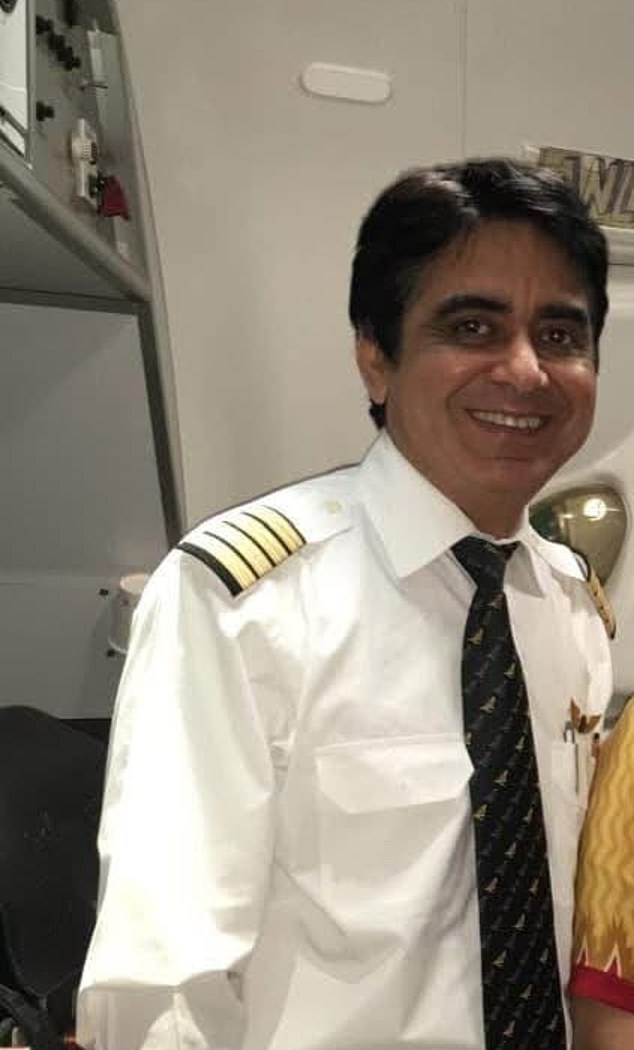
Investigations into the Air India plane crash are reportedly examining Captain Sumeet Sabharwal’s (pictured) medical records amid allegations that he had depression and mental health issues
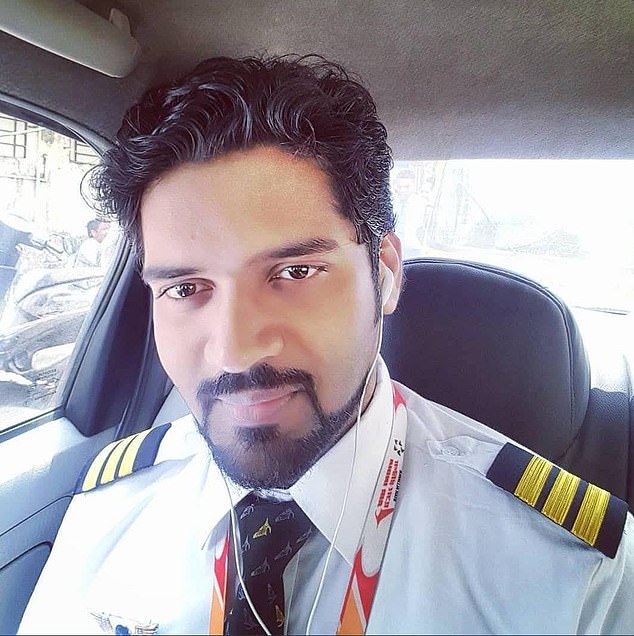
Captain Sumeet Sabharwal (pictured), an experienced pilot with more than 8,200 hours in the cockpit, was piloting the Boeing 787 Dreamliner with co-pilot Clive Kunder (pictured) when it plummeted into a residential area, called Meghani Nagar, killing 241 people on board and claiming 19 more lives of those on the ground
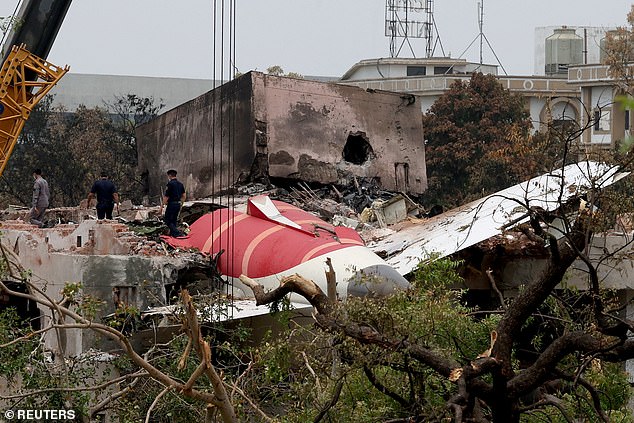
Now, investigations into the tragic crash (pictured) have begun to analyse the behaviour of the pilot, with Captain Mohan Ranganathan, a leading aviation safety expert in India, revealing that ‘several’ Air India pilots had confirmed that the well-experienced pilot had suffered from poor mental health
In Powai, Mumbai, one of Captain Sabharwal’s former colleagues described him as a ‘thorough gentlemen’ telling the publication that he believed ‘he was actually considering early retirement in the next couple of years’, with plans to look after his elderly father, aged 90.
In his short career, co-pilot Clive Kunder, 28, had logged more than 3,400 hours.
The Telegraph said that while Air India declined to comment, an official working with their parent company, Tata Group, told the publication that Captain Sabharwal had not taken any medical leave, with the preliminary report failing to obtain any significant findings.
They added that within the last two years, both pilots onboard the flight had passed the Class I medical exam, which makes an evaluation of their psycho-physical capabilities.
On Sunday, a preliminary report released by the Indian authorities led to questions about why the pilot would have manually turned the switches off – and whether it was a deliberate act or a catastrophic mistake.
The report said: ‘In the cockpit voice recording, one of the pilots is heard asking the other: why did he cut off? The other pilot responded that he did not do so.’
Pilots will turn the fuel switches on and off at the correct times in every flight, but this time the fuel was cut off straight after takeoff and the landing gear was not raised.
The co-pilot was flying the aircraft at the time of takeoff while the captain was monitoring.
The report added that the switches were flipped back to ‘run’ seconds afterwards, which started the process of relighting the engines.
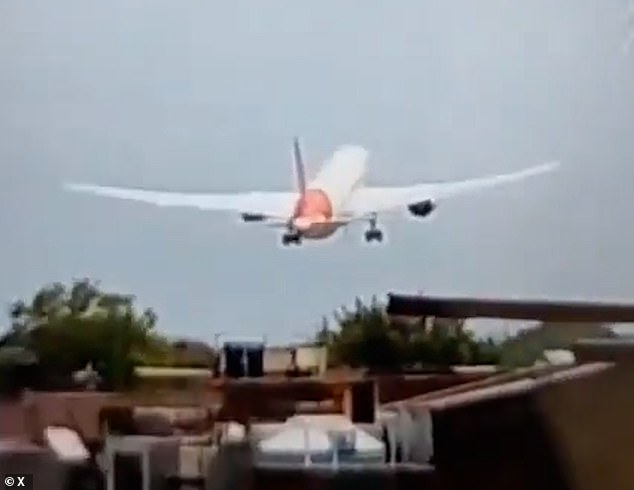
Seconds after taking off on June 12, two fuel switches in the cockpit of Air India Flight 171 were turned off shortly after take off, a preliminary report revealed on Sunday. Now, Captain Sabharwal is understood to have taken bereavement leave after the death of his mother, though it is believed by Mr Ranganathan that he had been ‘medically cleared’ by Air India
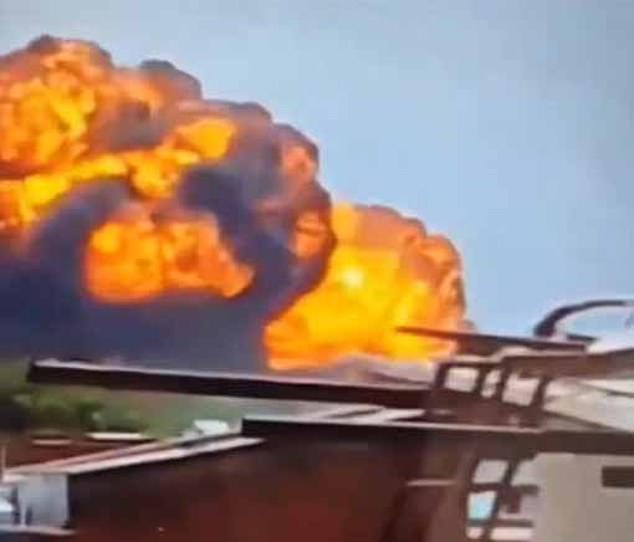
The plane momentarily disappeared from view behind trees and buildings before a massive fireball erupted on the horizon in this horrifying clip
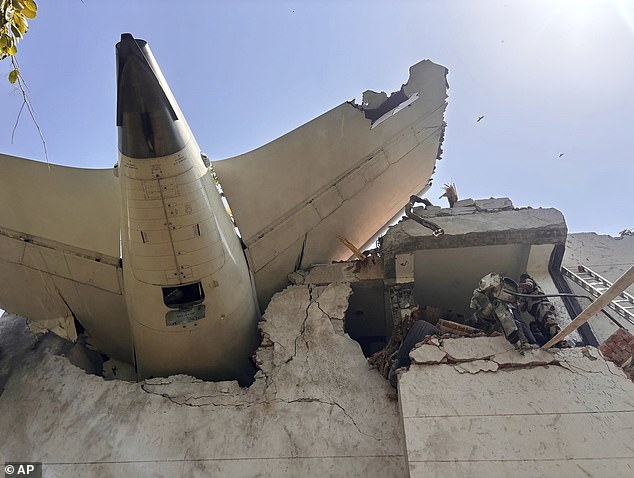
Pictures show the devastation after the plane crashed into a residential building. In Powai, Mumbai, one of Captain Sabharwal’s former colleagues told the Daily Telegraph that he was a ‘thorough gentlemen’
One of the engines had relit but had not gained power while the other was in the process of regaining power.
At the crash site, but switches were found in the ‘run’ position.
Before the flight, both pilots had an adequate rest period and were found ‘fit to operate’ following a breath analyser test, the report said.
There were no dangerous goods on the plane and the weight was ‘within allowable limits’.
Fuel samples taken from the tanks were tested and found to be ‘satisfactory’ and there was ‘no significant bird activity’ observed in and around the flight path of the aircraft.
But Mr Ranganthan previously suggested it may have been deliberate.
Each lever has to be pulled upwards to be unlocked, before it can be flipped and they also have further protective guard brackets to safeguard against any bumps and nudges.
Explaining that he believed it ‘had to be done manually’, Mr Ranganathan told NDTV of the fuel levers: ‘The fuel selectors they aren’t the sliding type they are always in a slot.
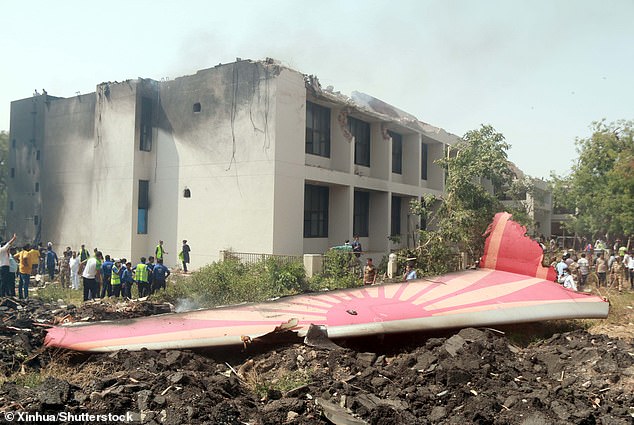
People look at the debris of an Air India plane crashed in Ahmedabad of India’s Gujarat state. Before the flight, both pilots had an adequate rest period and were found ‘fit to operate’ following a breath analyser test, the report said
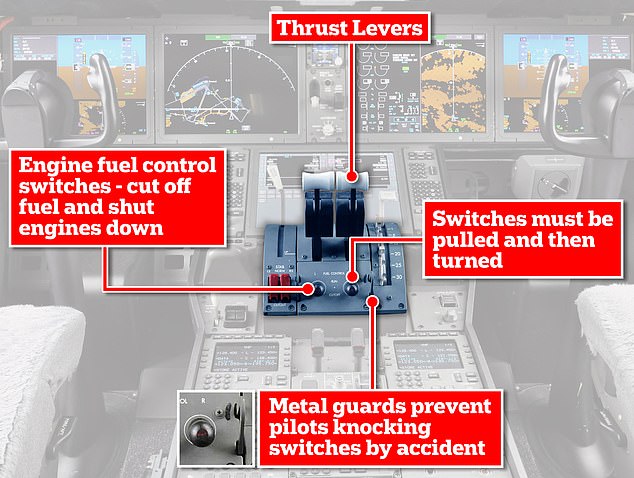
A graphic displaying how the lever on the Boeing 787 Dreamliner works
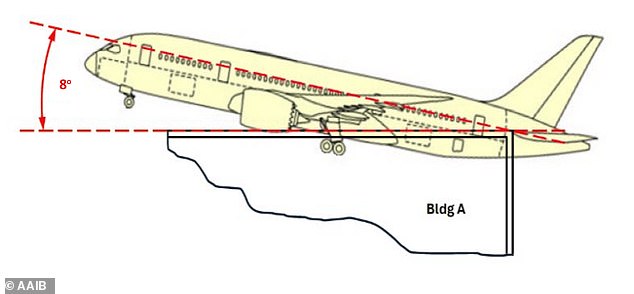
After losing altitude, it came into contact with Building A at 293ft at the angle illustrated above
‘They are to pull them out or move them up or down, so the question of them moving inadvertently out of off position doesn’t happen. It’s a case of deliberate manual selection.’
He later said ‘nothing else’ would explain why both switches were moved into the off position just after take off, alleging: ‘It had to be deliberately done.’
When questioned if he was suggesting one of the pilots ‘deliberately’ switched off the fuel lever, while fully aware of the possibility of a crash, he answered: ‘Absolutely’, before asserting they were looking at a potential ‘pilot-induced crash’.
But relatives of some of the victims of the crash have accused the airline and the Indian government of trying to blame the pilots for the crash.
Ameen Siddiqui, 28, whose brother-in-law, Akeel Nanabawa, died alongside his wife and their four-year-old daughter said: ‘This report is wrong. We don’t accept it.’
‘It’s a cover-up to protect Air India and the government,’ Mr Siddiqui told The Telegraph from Surat, south of Ahmedabad, where the plane crashed.
‘They want to blame dead pilots who can’t defend themselves. How can the fuel switches end up turning off at a critical moment, either through pilot error or a mechanical fault?
CCTV footage from the airport showed that the ram air turbine, known as the RAT, was deployed shortly after takeoff.
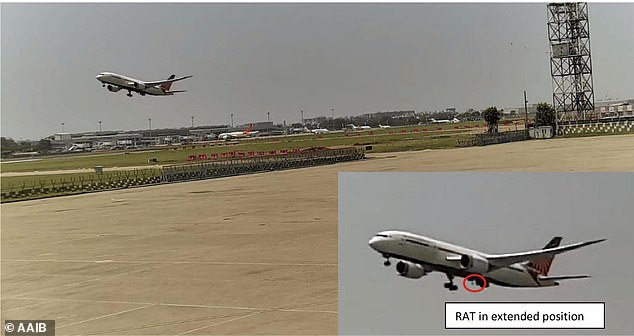
CCTV footage (pictured) from the airport shows the Ram Air Turbine (RAT) being deployed as the aircraft lifts off. Ameen Siddiqui, 28, whose brother-in-law, Akeel Nanabawa, died alongside his wife and their four-year-old daughter said: ‘This report is wrong. We don’t accept it’
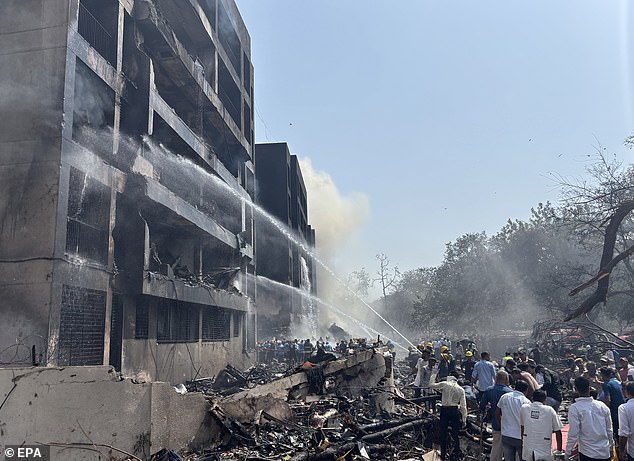
Firefighters work at the site of the crash near Sardar Vallabhbhai Patel International Airport
The RAT acts as a backup power source during emergencies and will deploy in cases of complete power failure.
The report said two minutes after takeoff, one of the pilots transmitted: ‘Mayday, Mayday, Mayday’.
In December 2018 the US air regulator Federal Aviation Administration (FAA) warned airlines that fuel switches had been installed in some Boeing 737s ‘with the locking feature disengaged’.
‘If the locking feature is disengaged, the switch can be moved between the two positions without lifting the switch during transition, and the switch would be exposed to the potential of inadvertent operation,’ the FAA warned in a Special Airworthiness Information Bulletin.
‘Inadvertent operation of the switch could result in an unintended consequence, such as an in-flight engine shutdown.’
It recommended airlines inspect the switches, including ‘whether the fuel control switch can be moved between the two positions without lifting up the switch’.
The airworthiness concern was not considered an unsafe condition that would warrant a legally enforceable regulation to correct unsafe conditions.
Air India has suggested such inspections were not carried out because the FAA’s bulletin was ‘advisory and not mandatory’.

A family member cries upon hearing the news of her brother who died when the Air India Boeing 787 Dreamliner plane crashed in Ahmedabad, India, June 12, 2025. An Air India spokesperson previously said: ‘Air India stands in solidarity with the families and those affected by the AI171 accident’
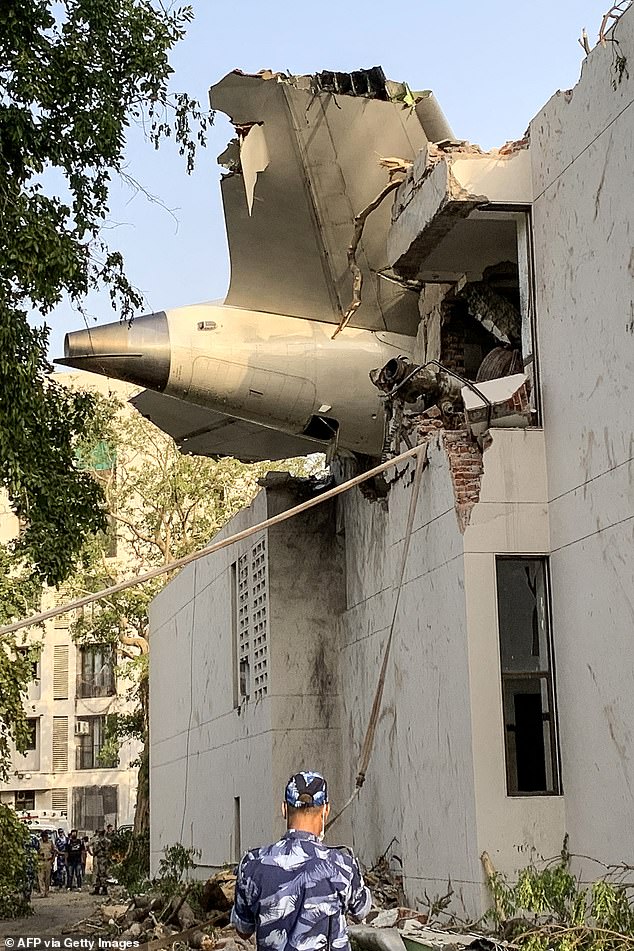
The tail of the plan and the RH Main Landing Gear (MLG) were found in the northeast wall of Building A (pictured)
Sole survivor Vishwash Kumar Ramesh had been in the country on a business trip with his brother Ajaykumar, 35, before they boarded the doomed flight travelling from Ahmedabad to Gatwick on Thursday.
In what has been described as a miracle, Viswash – seated in 11A by the exit – survived, but his sibling who was sat on the other side of the aisle in seat 11J perished in the fireball explosion.
Before the discovery of the British survivor, authorities said that they believed no one had escaped the flight alive.
Eleven of those on board were children, including two newborns.
An Air India spokesperson previously said: ‘Air India stands in solidarity with the families and those affected by the AI171 accident. We continue to mourn the loss and are fully committed to providing support during this difficult time. We acknowledge receipt of the preliminary report released by the Aircraft Accident Investigation Bureau (AAIB) today, 12 July 2025.
‘Air India is working closely with stakeholders, including regulators. We continue to fully cooperate with the AAIB and other authorities as their investigation progresses.
‘Given the active nature of the investigation, we are unable to comment on specific details and refer all such enquiries to the AAIB.’
Air India was contacted for comment.












